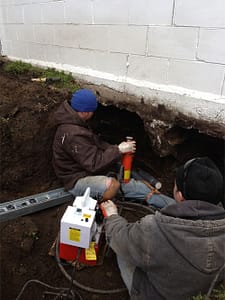Excitement About Best Basement Waterproofing
About Best Basement Waterproofing
Table of ContentsGet This Report about Best Basement WaterproofingLittle Known Facts About Best Basement Waterproofing.What Does Best Basement Waterproofing Mean?Getting My Best Basement Waterproofing To WorkMore About Best Basement Waterproofing
AdvantaClean's qualified experts and professionals will certainly situate the water source. If wall or slab fractures are present, we will certainly infuse polyurethane and epoxies into the fractures and seal the compromise, protecting against further wetness from getting in.Proper rating around the home to direct moisture away from the structure. Installing, repairing, or cleansing gutters and downspouts. Interior or outside waterproofing with filler, sealant, and/or water-proof paint. Mounting cellar ventilation systems, conditioning systems, or cellar dehumidifier systems to obtain water out of your cellar. Picking AdvantaClean's cellar waterproofing services is an efficient method to treat wetness and avoid mold from compromising the structure of your home and the wellness of your family members.
If there's condensation outside of the foil, you have high moisture in your basement. Fix it with a portable area dehumidifier or a whole-house humidifier system rather of waterproofing items. If the foil has condensation on the within surface area (beside the wall surface), the dirt around your house might be naturally damp from a high water table or poor dirt drainage.
You can waterproof simply your indoor wall surfaces, which may address the trouble. Once they dry, they stick completely to concrete and stonework walls.
The Definitive Guide for Best Basement Waterproofing
Concrete water resistant coverings can not be applied to previously repainted surfaces; check the label. Known as densifiers, they are suitable just for wall surfaces that have not been painted or sealed.
However you clean, roll, or spray it on a lot more heavily one gallon covers just 75 square feet, not the 300 square feet typical with typical paint. Waterproof paint is fine for do it yourself application. You can apply it over repainted surface areas, and paint over it once it's healed (one gallon costs $37).
It can set you back $10,000 to $15,000, depending on the work needed. Outside waterproofing involves excavating throughout the house fully depth of the structure walls, then installing a water-proof coating or membrane layer topped by drainage panels. The panels give a very easy path for water to flow to an exterior French drain at the base of your structure.
9 Easy Facts About Best Basement Waterproofing Shown
We've all been captured in a tornado without any umbrella or raincoat. And it's constantly a dish for disaster: every little thing's wet, your hairstyle is destroyed, and points are getting mildewy. her response A cellar without waterproofing is kind of like that. Minus the spoiled hairdo part. visit our website Your basement does not intend to go with a rainstorm without proper security simply as long as you don't wish to.
Outside waterproofing is a waterproofing technique that includes sealing your home from the outside. It's type my sources of like a moat around a castle. It includes digging a trench around your entire house to the structure (concerning 8 to 10 feet down). The structure wall surfaces are then cleaned, sealed, and covered with a water resistant membrane layer or sealer.

Indicators on Best Basement Waterproofing You Need To Know
It's a more engaged procedure that requires excavating up your lawn, which is expensive and taxing. Exterior waterproofing involves getting rid of every little thing surrounding your home, including verandas, driveways, sidewalks, landscaping, AC devices, decks, and so forth. If any of the job was done improperly and water is still entering your basement, there isn't much you can do to remedy or fix it.
Interior cellar waterproofing entails waterproofing from the within. Any type of water that leakages into your basement is rerouted prior to it touches your flooring.
It's a reliable technique to waterproof your basement. The disadvantage of indoor basement waterproofing mainly pertains to the installment process. This technique calls for stored products, furnishings, and integrated shelving or closets to be moved from touching the basement walls. And throughout installment, your cellar can't be used. The largest difference between both approaches is this: Outside waterproofing is a preventative solution and interior waterproofing is a restorative remedy.
The Ultimate Guide To Best Basement Waterproofing
To conclude, exterior and interior basement waterproofing are both efficient techniques of protecting your home from water damage. Exterior waterproofing produces a barrier that prevents water from entering your home, while interior waterproofing reroutes water that does enter your home. And it is essential to keep in mind that exterior waterproofing is a costly and disruptive installment procedure when contrasted to indoor waterproofing.
Whichever approach you select, see to it you choose a reliable and reliable specialist for the task. Both methods need skilled employees to handle the work. If you have any type of questions about cellar waterproofing, please connect to us. And if you're in our solution area and have water in your cellar, contact us for a free, no-obligation home assessment.
You can fill in our kind here. Best Basement Waterproofing, begin a conversation in the lower right-hand corner, or call us at 1-800-827-0702